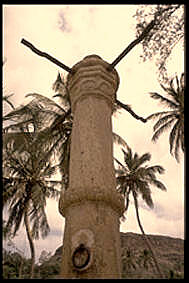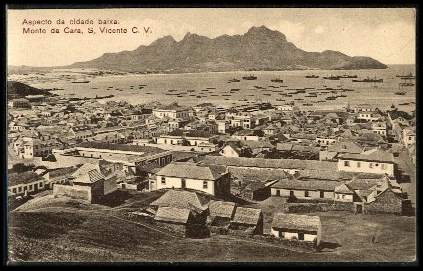|
Santiago, Cape Verde
Santiago (Portuguese language, Portuguese for “James, son of Zebedee, Saint James”) is the largest island of Cape Verde, its most important agricultural centre and home to half the nation's population. Part of the Sotavento Islands, it lies between the islands of Maio, Cape Verde, Maio ( to the east) and Fogo, Cape Verde, Fogo ( to the west). It was the first of the islands to be settled: the town of Ribeira Grande (now Cidade Velha and a UNESCO World Heritage Site) was founded in 1462. Santiago is home to the nation's capital city of Praia. History The eastern side of the nearby island of Fogo, Cape Verde, Fogo collapsed into the ocean 73,000 years ago, creating a tsunami high which struck Santiago. In 1460, António de Noli became the first to visit the island. Da Noli settled at ''Ribeira Grande'' (now Cidade Velha) with his family members and Portuguese from Algarve and Alentejo in 1462. [...More Info...] [...Related Items...] OR: [Wikipedia] [Google] [Baidu] |
Pico De Antónia
Pico de Antónia is a mountain located in the central part of the island of Santiago in Cape Verde. At , it is the highest point of the island. The mountain is part of the protected area ''Parque Natural da Serra do Pico de Antónia''.Resolução nº 36/2016 Estratégia e Plano Nacional de Negócios das Áreas Protegidas The towns Picos and Assomada lie close to the mountain. The Serra do Pico da Antónia has been identified by as an |
Fogo, Cape Verde
Fogo (; Portuguese language, Portuguese for "fire") is an island in the Sotavento Islands, Sotavento group of Cape Verde in the central Atlantic Ocean. Its population is 35,837 (2015),Cabo Verde, Statistical Yearbook 2015 Instituto Nacional de Estatística (Cape Verde), Instituto Nacional de Estatística with an area of 476 km2. It reaches the highest altitude of all the islands in Cape Verde, rising to above sea level at the summit of its active volcano, Pico do Fogo. History The eastern side of Fogo collapsed into the ocean 73,000 years ago, creating a tsunami 170 meters high which struck the nearby island of Santiago, Cape Verde, Santiago. Fogo was discovered in 1460 by Genoa, Genovese captain Antóni ...[...More Info...] [...Related Items...] OR: [Wikipedia] [Google] [Baidu] |
São Vicente, Cape Verde
São Vicente (Portuguese language, Portuguese for "Vincent of Saragossa, Saint Vincent") is one of the Barlavento Islands, the northern group within the Cape Verde archipelago in the Atlantic Ocean, off the West Africa, West African coast. It is located between the islands of Santo Antão, Cape Verde, Santo Antão and Santa Luzia, Cape Verde, Santa Luzia, with the Canal de São Vicente separating it from Santo Antão. Geography The island is roughly rectangle, rectangular in shape with an area of . From east to west it measures and from north to south .Cabo Verde, Statistical Yearbook 2015 Instituto Nacional de Estatística (Cape Verde), Instituto Nacional de Estatística The island, of volcano, volcanic origin, is fairly flat. The last volcanic activity is considered to have t ... [...More Info...] [...Related Items...] OR: [Wikipedia] [Google] [Baidu] |
Mindelo
Mindelo is a port cityCabo Verde, Statistical Yearbook 2015 Instituto Nacional de Estatística (Cape Verde), Instituto Nacional de Estatística, p. 32-33 in the northern part of the island of São Vicente, Cape Verde, São Vicente in Cape Verde. Mindelo is also the seat of the parish of Nossa Senhora da Luz, and the municipality of São Vicente, Cape Verde, São Vicente. The city is home to 93% of the entire island's population and is Cape Verde's second most populous city and largest city in Barlavento Islands. Mindelo is also considered the cultural capital of Cape Verde, known for its colourful and animated carnival celebrations, with roots in Culture of Portugal, Portuguese traditions later influenced by the Brazilian culture. History [...More Info...] [...Related Items...] OR: [Wikipedia] [Google] [Baidu] |
Cassard Expedition
The Cassard expedition was a sea voyage by French Navy captain Jacques Cassard in 1712, during the War of the Spanish Succession. Targeting English, Dutch, and Portuguese possessions, he raided and ransomed the colonies of Cape Verde, Sint Eustatius, and Curaçao—factories, depots, and seasoning camps used in the Atlantic slave trade. He also raided and ransomed Montserrat, Antigua, Surinam, Berbice, and Essequibo—wealthy sugar-producing colonies in the Caribbean whose economies were based on the exploitation of slave labor. In many of the places he landed, officials paid a ransom to avoid pillage; this was not always successful, as Cassard sometimes ignored the terms of the agreements he made. At the end of its expedition, Cassard's squadron returned to France with prizes in the form of cash, goods, and enslaved Africans worth between nine and ten million French livres. Cassard's exploits won him the Order of Saint Louis. Effects on the fortifications, enslaved popula ... [...More Info...] [...Related Items...] OR: [Wikipedia] [Google] [Baidu] |
Jacques Cassard
Jacques Cassard (30 September 1679 – 1740) was a French naval officer and privateer. Biography Born on 30 September 1679 to a family of merchants of Nantes, Cassard began a career as a sailor at age 14 on the merchantmen owned by his family. In January 1697, he joined the French Navy on bombship ''Éclatante''. In 1700, Cassard became a merchantman captain. The next year, the War of the Spanish Succession broke out, and Cassard converted to a privateer. In 1705, he captained the privateer ''Saint Guillaume'', capturing 12 merchantmen and raiding Cork. Two years later, he captured 13 merchantmen with the ''Duchesse Anne'', earning a rank in the Navy. In 1709, Cassard, promoted to Commander, was tasked to escort a 25-ship food convoy on the 68-gun ''Éclatant''. On 29 April, supported by ''Sérieux'', he defeated five English ships, allowing the convoy to safely reach Marseille. The next year, Cassard lead a squadron comprising the 74-gun ''Parfait'', the 58-gun ''S ... [...More Info...] [...Related Items...] OR: [Wikipedia] [Google] [Baidu] |
Capture Of Santiago (1585)
The Capture of Santiago was a military engagement that took place between 11 and 28 November 1585 during the newly declared Anglo-Spanish War. (Santiago is the largest island of the Cape Verde archipelago.) An English expedition led by Francis Drake captured the port town of Cidade Velha in the Cape Verde islands that had recently belonged to the Crown of Portugal. He sacked it and then marched inland before doing the same at São Domingos and Praia. Afterwards Drake left and continued his expedition to successfully raid the Spanish possessions in the Americas.Bicheno 186-88 Background War had already been declared by Philip II of Spain after the Treaty of Nonsuch in which Elizabeth I had offered her support to the rebellious Protestant Dutch rebels. The Queen through Francis Walsingham ordered Sir Francis Drake to lead an expedition to attack the Spanish New World in a kind of preemptive strike.Mancall p. 166-67 Expedition The expedition gathered at Plymouth on 14 Septem ... [...More Info...] [...Related Items...] OR: [Wikipedia] [Google] [Baidu] |
Francis Drake
Sir Francis Drake ( 1540 – 28 January 1596) was an English Exploration, explorer and privateer best known for making the Francis Drake's circumnavigation, second circumnavigation of the world in a single expedition between 1577 and 1580 (being the first English expedition to accomplish this). He is also known for participating in the early English slaving voyages of his cousin, John_Hawkins_(naval_commander), John Hawkins, and John_Lovell_(slave_trader), John Lovell. Having started as a simple seaman, in 1588 he was part of the fight against the Spanish Armada as a vice admiral. At an early age, Drake was placed into the household of a relative, William Hawkins (died c. 1554), William Hawkins, a prominent sea captain in Plymouth. In 1572, he set sail on his Francis Drake's expedition of 1572–1573, first independent mission, privateering along the Spanish Main. Drake's circumnavigation began on 15 December 1577. He crossed the Pacific Ocean, until then an area of exclusive ... [...More Info...] [...Related Items...] OR: [Wikipedia] [Google] [Baidu] |
António De Noli
Antonio de Noli (born 1415 or possibly 1419) was a 15th-century Genoese nobleman and navigator, and the first governor of the earliest European overseas colony in Subsaharan Africa. He discovered some of the Cape Verde islands on behalf of Henry the Navigator and was made the first Governor of Cape Verde by King Afonso V. In most history or geographic books, including ancient chronicles, or encyclopedias, he is referred as ''Antonio de Noli''. In Italy, he is known also as ''Antonio da Noli'' or sometimes as ''Antoniotto Usodimare''. Biography Antonio de Noli was born to a patrician family in Genoa, Italy, as referred in ancient sources of the epoch; e.g. Portuguese king's historian João de Barros stated already in 1552 that Antonio Noli was born in Genoa, and "of noble blood". Modern historians and researches also specify Antonio Noli as ''Genovese'' or ''Genoese'', e.g. Dumoriez (1762), Thomas (1860), Hamilton (1975), Diffie and Winius (1977), Irwin and Wilson (1999). It has ... [...More Info...] [...Related Items...] OR: [Wikipedia] [Google] [Baidu] |
Picos, Cape Verde
Picos, also known as Achada Igreja, is a cityCabo Verde, Statistical Yearbook 2015 Instituto Nacional de Estatística (Cape Verde), Instituto Nacional de Estatística, p. 32-33 in the central part of the island of Santiago, Cape Verde, Santiago, Cape Verde. It is the seat of São Salvador do Mundo, Cape Verde, São Salvador do Mundo municipality. Picos is located 4 km southeast of Assomada and 23 km northwest of the capital city of Praia, near the national road from Praia to Tarrafal, Cape Verde, Tarrafal via Assomada (EN1-ST01). Picos is surrounded by mountains, and lies about 4 km north of the highest peak of the island of Santiago, Pico de Antónia. FIle:Igreja de São Salvador do Mundo, Picos, Cape Verde.jpg, São Salvador do Mundo church History |
Serra Malagueta CV
Serra (Latin for "saw") may refer to: People and fictional characters * Serra (surname), a list of people and fictional characters * Serra (given name), a list of people and fictional characters * Serra (footballer), Portuguese footballer José Carvalho Gonçalves (born 1961) Cities, towns, municipalities Brazil * Serra, Espírito Santo, a city in the Greater Vitória area * Serra Azul, in São Paulo * Serra do Navio, in Amapá * Serra do Navio, in Amapá * Serra Negra, in São Paulo * Serra Talhada, in Pernambuco Italy * La Serra, San Miniato, in Tuscany * Serra (Rocca Santa Maria), in Abruzzo * Serra d'Aiello, in Calabria * Serra de' Conti, in Marche * Serra Pedace, in Calabria * Serra Riccò, in Liguria *Serra San Bruno, in Calabria * Serra San Quirico, in Marche * Serra Sant'Abbondio, in Marche Portugal *Serra (Tomar), in Santarém * Serra de Água, in the Madeira Islands * Serra do Bouro, in Caldas da Rainha San Marino * La Serra, in Acquaviva Spain *Serra, Cape Verde ... [...More Info...] [...Related Items...] OR: [Wikipedia] [Google] [Baidu] |
Pelourinho
The Historic Center ( US) or Centre ( UK) () of Salvador de Bahia in Brazil, also known as the ( Portuguese for "Pillory") or Pelo, is a historic neighborhood in western Salvador, Bahia. It was the city's center during the Portuguese colonial period and was named for the whipping post in its central plaza where enslaved people from Africa were publicly beaten as punishment for alleged infractions. The Historic Center is extremely rich in historical monuments dating from the 17th through the 19th centuries. Designated a UNESCO World Heritage Site, the retains a vibrant repertoire of colonial Portuguese architecture, exemplified by the Mannerist decoration of the Cathedral of Salvador, the Baroque intricacy of the Church and Convent of São Francisco and the Church of the Third Order of Our Lady of the Rosary of the Black People. In addition, the remains a cultural hub for the Afro-Brazilian community, whose cuisine, architecture, religion and music exert a salient inf ... [...More Info...] [...Related Items...] OR: [Wikipedia] [Google] [Baidu] |







